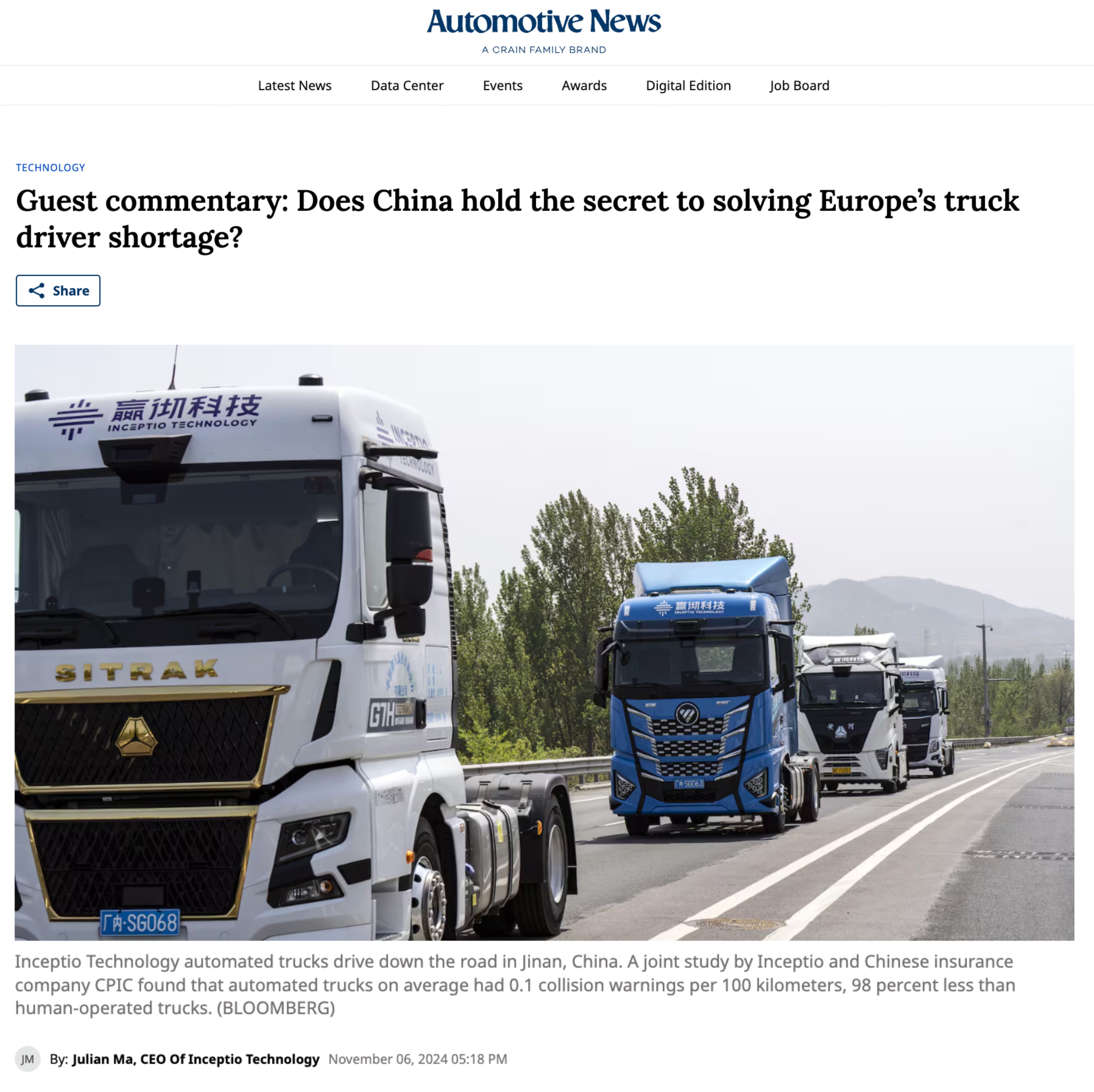
Does China hold the secret to solving Europe’s truck driver shortage?
2024-11-12
Introduction
As Europe grapples with a severe truck driver shortage—projected to reach 745,000 by 2028—it's clear that innovative solutions are urgently needed. The challenges are multifaceted, from difficult working conditions to an aging workforce. In a commentary published on Auotmotive News, Julian Ma, Inceptio Technology’s CEO, offers insights from China’s deployment of L3 and L2+ autonomous truck technology that can provide a pathway forward. With over 1,000 autonomous trucks already in operation, these technologies are not only enhancing safety and comfort for drivers but also significantly reducing fatigue and collision risks.
As we look to the future, embracing these advancements may be crucial for attracting new talent and ensuring the sustainability of the logistics industry. The shift towards autonomy is not just a trend; it's a irreversible transformation.
article link: https://www.autonews.com/technology/an-guest-commentary-inceptio-china-europe-truck-driver-shortage/

The global logistics industry is facing a severe truck driver shortage, with Europe particularly affected. According to the International Road Transport Union, Europe, Norway and the U.K. are missing an estimated 233,000 drivers, with this number expected to more than triple to 745,000 by 2028 if no action is taken. Over half of European trucking companies have reported that they are unable to expand their businesses due to driver shortages, which has reduced productivity for nearly half of companies.
The root causes are multifaceted. As a profession, truck driving has become less appealing due to high labor intensity, extended periods away from home and challenging working conditions. These factors directly contribute to poor lifestyle habits among drivers, which lead to fatigue, significant health issues and increased risk of accidents. The profession also faces a generational divide and high barriers to entry, with a third of European truck drivers now older than 55 and expected to retire within a decade, while less than 5 percent are under 25. The workforce is also less diverse, with women making up only about 6 percent. Further diminishing the attractiveness is the relatively low compensation drivers receive considering the level of hardship endured.
How Europe can learn from China on automated trucks
The experience of Level 2 and Level 3 automated truck technologies in China may offer valuable reference for Europe. These technologies are mature solutions that are widely deployed in China, transforming the logistics industry by effectively addressing many of the core issues. Trucks with automated technologies materially improve working conditions for drivers, enhancing the job's attractiveness by making it safer, more comfortable and less labor-intensive. Since 2022, Inceptio Technology has successfully partnered with five automakers on serial production of more than 1,000 trucks with Level 2 and Level 3 technologies, which have been successfully deployed across the line-haul logistics sector in China. Studies have shown that trucks equipped with these automated driving systems record significantly lower collision warnings compared to conventional trucks. For example, a joint study by Inceptio and Chinese insurance company CPIC found that automated trucks on average had 0.1 collision warnings per 100kilometers, 98 percent less than human-operated trucks. Another study demonstrated that drivers using automated systems for most parts of their journeys experience 35 per cent less physiological fatigue and 11 percent less psychological fatigue than those operating conventional trucks. Since the driving experience has been transformed to be so much safer, more comfortable and stress-free, drivers don't want to go back to manual mode.
Automated trucks' benefits for drivers
With such technology, the role of the driver has transformed into more of a safety operator, with many of the complex driving tasks now automated. The systems' user-friendly nature and improved safety and comfort makes the job more appealing to a broader demographic, for example younger drivers and women.
They also offer substantial cost savings and efficiency improvements. The systems prioritize fuel efficiency in their driving decisions. Data from Inceptio shows fuel consumption per 100 kilometers falling by 3 to 7 percent, resulting in a significant reduction in emissions as well.
Fully driverless technology has yet to be realized, whereas automated driving technology is a convenient solution to Europe's truck driver shortages, which have plagued the industry for the last decade. Inceptio's achievement in China serves as a strong case on the benefits and maturity of Level 2 and Level 3 driving.
With the global economy facing macroeconomic headwinds and increasing pressure to meet environmental targets, it is ever more challenging for European logistics companies to reduce costs, attract drivers, contribute to sustainability and stay competitive. Automated trucking technology is readily available and proven to be highly effective in addressing these challenges. Just as the shift from manual to automatic in the past, the advent of automated driving technology is irreversibly transforming the logistics industry and setting a new and improved standard for the future.